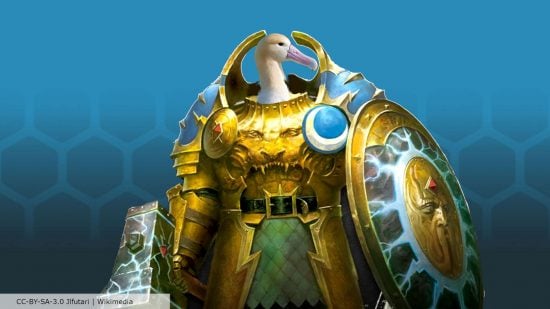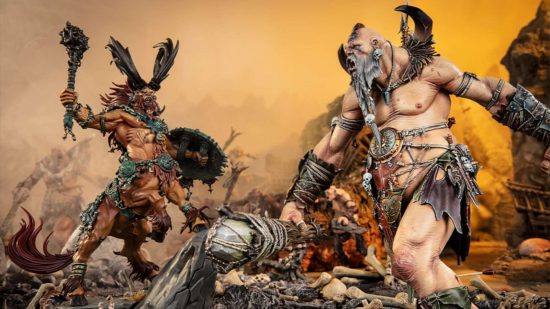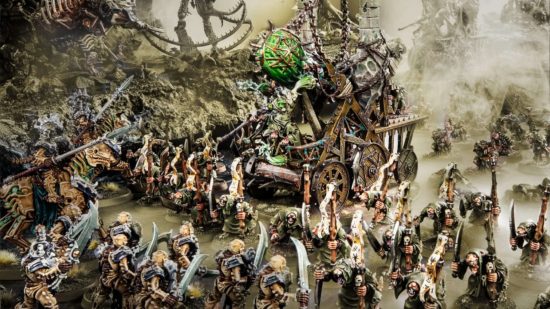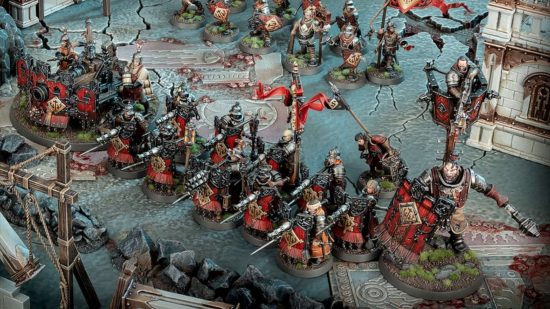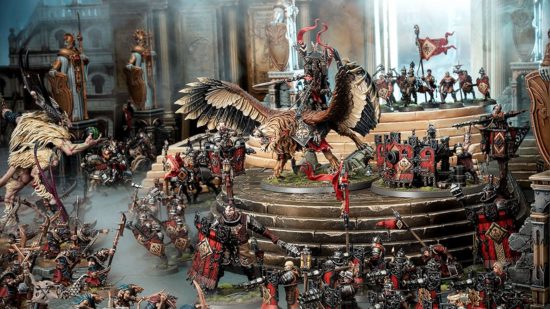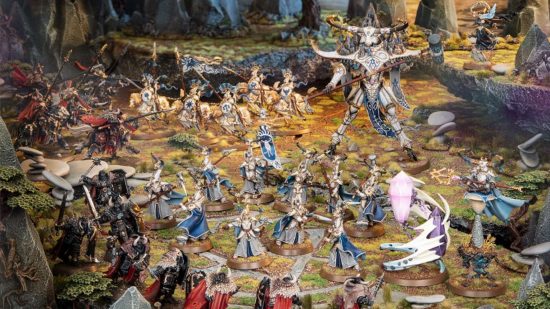The Age of Sigmar double turn mechanic is one of the most unusual, and controversial, aspects of the game. It’s also a fundamentally flawed mechanic that, if it can be salvaged at all, needs to be reconceived from the ground up.
To make my perspective clear, I enjoy Age of Sigmar plenty. I’m rubbish at it, of course, because I’m a games reviewer: I don’t have the time to get good at any one game when I have another five on the to-play pile. Just take this as game design analysis, not salt: I will lose at Age of Sigmar whether or not the double turn is there.
For the benefit of anyone not familiar with the mechanic, here’s how the double turn works. Each battle round, both players roll for priority. The winner of the roll off gets to pick if they go first or second – in the case of ties, the current first player wins. This means that a player who goes second in one round could go first in the next, giving them two turns in a row: a double turn.
While plenty of miniature wargames randomise the activation order of individual units – Bolt Action, Judge Dredd, Through the Mud and the Blood, to name a few – they’re all alternating activation games, in which a player gets to activate one unit before the next unit is selected. Age of Sigmar is an I-go-you-go game, in which players take it in turns to activate their entire Age of Sigmar army.
The roll for priority creates interesting game decisions. The first player must be cautious in how they use their forces, as they’re vulnerable to their opponent attacking two turns in a row. If the second player takes a double turn, all their spells and abilities with a one-turn duration expire and they need to recast them or spend Command Points to get them back. They’ll be open to a double turn in the future: it’s not always the right choice to take the double turn.
The problem is the sheer weight of tactical advantage that hangs on a single die roll. Game designers call the gap between the best and worst outcomes from something random (like a die roll) the ‘delta of randomness’. There’s no perfect delta of randomness: low deltas of randomness make a game predictable, while high deltas of randomness make chance more of a factor.
I can’t think of any die roll in any wargame with a higher delta of randomness than the roll for priority in Age of Sigmar. Two turns in a row is often a massive benefit, letting armies with magic or ranged attacks shoot twice, or a melee army two turns of charging and picking the first unit to fight. While the original first player may get a chance at a double-turn later, their forces will be diminished, so their double-turn will be weaker – assuming they survive long enough to take it.
What is this rule supposed to achieve? When we consider the first edition of Age of Sigmar in the context Games Workshop released it – as a complete reversal in game design philosophy from the original Warhammer Fantasy Battle – we can infer some of the principles underlying it.
With just four pages of rules and extremely simplified combat system, it was supposed to be a quick playing and simple ruleset; with the double turn and the Sudden Death table (which gave a player falling behind a single objective to claim victory), it was supposed to prioritise drama by creating amazing comeback stories.
Except, the double turn is too random to achieve that. It can create great comeback stories, but it can also double down on a beating for a player who’s losing – not so much dramatic, as miserable. And particularly in its raw state it’s not good for competitive play, as it becomes incredibly hard for players to plan around the future state of the game.
We can see a tacit acknowledgment of this in the way GW has toned down the impact of the double-turn in both second and third edition AoS. There are now more benefits to staying as the second player and not taking a double turn: control over endless spells, additional command points, a better position for scoring objectives.
This has shrunk the delta of randomness of the priority roll, making it less obvious whether taking first or second player in the turn is the better choice.
But weighting the second turn with advantages also gives a bonus to the player who starts in the turn two position – the same player who has first shot at a double turn. And if there is a clearly better choice about taking the double turn or not – and there usually is – that choice goes to a randomly selected player.
I think that the roll for priority and double turn are what Riot Games’ head designer Alex Jaffe calls “cursed problems” – game design problems that cannot be solved because they’re rooted in conflicting promises to the player. The double turn is an attempt to use a very simple system – a single die roll – to introduce a very dramatic outcome – comebacks – in a game that wants to provide an even playing field for competition.

Age of Sigmar fourth edition keeps the double turn, despite being a ground-up re-imagining of the rules. There are many ways the developers could have iterated on it: perhaps they’ve continued the direction of travel of 2e and 3e and given more benefits to the second player. Maybe they’ve done away with the priority roll altogether, changing it from a moment of explosive chance into something that uses resources, like command point bidding.
Perhaps they have managed to create a version of the rule that is simple, dramatic, and competitive. If so, it must have been a massive effort on the part of the designers. The payoff will be retaining a divisive mechanic that has become synonymous with the game’s identity. The cost is everything they didn’t work on when they were trying to fix it.
Even so, I’m very excited for the new edition, and looking forward to constructing an Age of Sigmar Skaven army (assuming I don’t rebase them all to build a Warhammer: The Old World Skaven force). While GW hasn’t revealed which minis are coming yet, Wargamer has a rundown on 10 new units hidden in the Age of Sigmar 4th edition trailer – did you spot them all?
